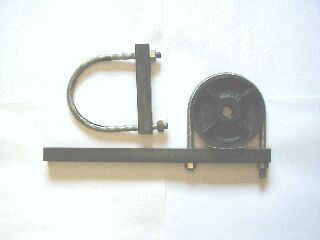
For Stanleys: A Simple Piston Wrench
Sooner or later, anyone who drives a Stanley a lot will have to do some engine repair work. The most kikely job is truing up the piston rods. They suffer wear in the cylinder stuffing box, especially if old asbestos packing is still in use, and are very likely to get bent in the event of water entering the cylinder.
While it is possible to work on the rods with the cylinder and crankcase stuffing boxes still in place, it is much easier if they are removed. That, of course, requires removing the piston, and, even after only a year's use, the piston can be remarkably recalcitrant. Having found from experiment that my chuck will unscrew form the lathe spindle at a small fraction of the torque needed to unscrew the piston, I decided to make suitable wrenches for the task.
I decided that the wrench should primarily grip an area that would not be a problem if scarred by the wrench, the bottom of the piston ring groove. Thus, I made "U" bolts out of threaded rod that fits the groove, 3/8 inch diameter. These pass through holes, on 3 7/8 centers for a 20 hp. piston, in pieces of 3/4 inch square steel bar, which is the same thickness as the half piston. I made one wrench with a very short bar, to be clamped in a vice. The other wrench uses a bar one foot long, which gives adequate leverage once the piston has been loosened. For the extra torque needed to start the piston, slip a piece of one inch iron pipe over the 3/4 inch bar. An eighteen inch length is adequate, and fits nicely. A thin piece of aluminum or copper is used between the bar and the piston to prevent scarring at that point.

Stanley pistons were made in two halves, one serving as lock nut for the other. This allowed the use of a very simple casting while still providing a hollow piston. Some Stanley pistons were further secured with a steel lock nut on the piston rod. These are the easier to remove safely. One simply uses force to unscrew the lock nut, in spite of the usual staking of the end of the rod to prevent unscrewing. Then, one cleans up the threads on the rod with a thread file, and the pistons may be unscrewed without damage.
However, many Stanley pistons had the rod staked into the piston itself, no lock nut being used. In this case, forcibly unscrewing the piston invariably wrecks its thread as the iron of the piston is much softer than the staked steel rod. After the first half has been removed, the rod threads can be repaired with a thread file and the second half unscrewed without damage. The damaged first half of the piston MUST NOT be reused in reassembling the engine, its damaged threads will no longer take the load and cylinders have been destroyed by pistons which came loose while in service.
For this reason, I do not stake the rod when assembling the piston, but simply rely on screwing the halves together as tightly as possible. So far, they have given me no trouble.
While I have not tried this, I can suggest a way to reuse the damaged piston half. Bore it out and thread it for a larger NF bolt, 7/8-14 for example. Then make a bushing from a piece of such a bolt by boring and tapping it to fit the piston rod, 11/16-18. This may actually result in a piston stronger than new!
The actual straightening and truing of the piston rod I will leave as an exercise for the student. (I am not yet very good at it, myself!)
Return to Steam Help
Last update: 20 January, 2001.